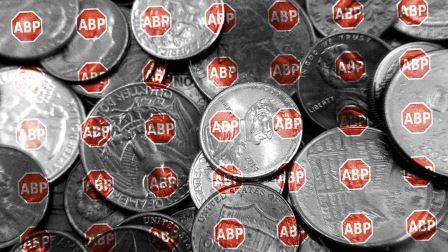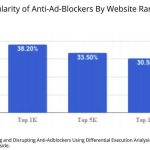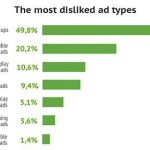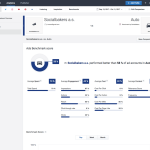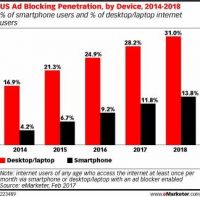Adblock Plus Says It Knows How To Get Consumers To Pay For Content
“Just because people block ads doesn’t mean they hate publishers,” claims Linus Olsson, the cofounder of Flattr. The Swedish entrepreneur thinks that he has come up with a possible solution to the fierce debate over ad-blocking software, which consumers love but that robs online content providers of the revenue they need to survive.
Flattr is a service that allows people to donate money to any online content provider they like—from major publishers to indie artists. The Swedish company says that it has enabled contributors to fund 30,000 creators since its founding in 2010, with some artists receiving thousands of dollars a month.
Today, Flattr announced a potentially huge expansion through a deal to integrate with AdBlock Plus, the ad-busting browser extension that has been downloaded more than half a billion times, says parent company Eyeo.
That deal may not provide immediate encouragement to online publishers feeling the squeeze, based on data collected by PageFair. The company offers a service to let publishers bypass blocking software—only for ads that meet strict standards, such as being unobtrusive and providing a clear opt-out button.
A study by PageFair and Adobe in August 2015 (still considered the best source by people in the industry) estimates the value of ads blocked per year at $21.8 billion. Meanwhile, Flattr and Eyeo say they aim to raise half a billion dollars for publishers next year.
Flattr declined to provide figures, even within an order of magnitude, about how many contributors it has or how much money it has raised for creators over the years. “We have decided not to disclose those,” says Flattr’s other cofounder, Peter Sunde, who also helped launch the notorious torrent-tracking site The Pirate Bay. “Also, I don’t think we can give out all the information for Swedish law reasons,” he says. Sunde didn’t go into details, but he has some experience with Swedish law. In 2009, he and three other Pirate Bay cofounders were sentenced to a year in prison for distributing content illegally. (Sunde served five months.)
“The problem [for Flattr] is not to get people to use it,” says Sunde. “It’s to get people to have the possibility to use it.” Currently Flattr has to convince each media producer (such as a website or podcast provider) to set up a PayPal-like account that allows them to receive contributions from users, he says. “We would have to do a deal with all these companies,” says Sunde, “and we don’t have those resources.”
Flattr can quickly get a lot bigger by integrating with Adblock Plus. “The reason this can work now is because of scale,” says Eyeo spokesman Ben Williams. “We have tens of millions of users.” The companies will start signing up beta users of the integrated service toward the end of May, with the goal of launching it by the end of the year. By then, Flattr will be completely automated, says Sunde. Users will budget a certain amount of money per month, as they do now. But instead of requiring users to users to click to contribute, Flattr will use a new algorithm to divvy up the funds automatically by analyzing people’s consumption—such as how long they stay on a web page or how long they watch a video. (Flattr is already doing this through integration with podcast apps including Podcast Addict, Pod Care, and BeyondPod, which pay out more money the longer people listen.) Content providers would still have to set up an account to collet their contributions; and Eyeo and Flattr will split up a transaction fee of perhaps 10%, says Williams.
Publishers Warming Up—Or Wearing Down
Donations aren’t the whole solution, but they can be part of a tiered approach, says Williams. Eyeo’s software allows “whitelisted” advertisements that have been pre-approved as meeting the company’s acceptable ad guidelines—for example, not allowing pop-ups that obscure content. (Publishers who sign up pay a 30% fee on whitelisted ads that go through, after the first 10 million.) Adblock Plus users can also opt to block all advertisements, and Flattr is a way to reach these people, says Olsson. “They understand that okay, I might be doing something that is monetarily bad for these sites that I’m visiting, but I still don’t want these ads. So what else can I do?” he says. “And that’s where we’re stepping in.”
Blockers aren’t getting much love from the ad industry. Interactive Advertising Bureau president Randall Rothenberg recently called Eyeo “an unethical, immoral, mendacious coven of techie wannabes.” But publishers are starting to consider a future of dwindling revenue. “There’s been a chase for eyeballs and ad dollars to fund it,” says Jason Kint, CEO of Digital Content Next (DCN)—an association of over 70 major media companies including ABC, the Associated Press, Bloomberg, Conde Nast, Viacom, and USA Today. “But a natural evolution would be diversifying that revenue, and I think that ad blocking is one of those topics that just accelerates that discussion,” he says.
Ad alternatives could include both tipping systems and paywalls. (The Reuters Institute Digital New Report 2015 estimates that about 10% of online users are paying for access to news sites.) “Anything that tightens the relationship directly between the consumer and where they’re getting their value…is a good thing,” says Kint.
This evolution is opening a gap between advertisers and publishers. “The reality is, the advertisers aren’t as impacted by [ad blocking] in the short term, because there’s plenty of places to buy inventory,” says Kint. “It’s really a publisher-driven problem and solution.” DCN issued a report to members in December telling them that, “you gotta take more control over third-party ad tech on your site,” says Kint.
Small Payments vs. Big Media
Flattr is one of several options allowing people to pay what they want online. Atri.me, for instance, is an experimental platform launched in March that allows people to set up a $10-per-month fund for content. The money is automatically divided among the sites someone visits each month. Ten dollars is a good amount, according to calculations by Atri.me. creator Matt Mankins. “If you look at the online advertising spend for display ads in the U.S. and divide that by the number of people online…you get a number that’s about six dollars and 50 cents,” he says. (Mankins is a former CTO of Fast Company parent Mansueto Ventures and is piloting technologies with the company.)
Atri.me divvies up payments based on Twitter accounts: If both the publication’s and the author’s handles appear on the page, each will get a chunk of the proceeds. That gives it some overlap with creator-focused services like Patreon, which allows fans to provide regular support for people like writers, musicians, painters, and filmmakers. Patreon is in the spirit of other crowdfunding sites like Indiegogo, but with a focus on sustained support for artists beyond single projects.
Crowdfunding artists may sound tangential to a business deal between Adblock Plus and Flattr to help publishers gain some non-ad revenue. But the real issue guiding Flattr’s founders is democratizing control of media. “It’s about helping creativity, solving issues so we get out of the centralization of media control, especially true for the Hollywood industry and music industry, which have about 10 companies that own most of the culture,” Sunde writes in a follow-up email to our call.
Flattr’s philosophy aims to be as big a challenge as ad blocking itself is to the overall media model—one with payments based on contracts, set royalties, or onetime “work for hire” fees. “I stay true to my word,” writes Sunde. “I think Flattr will be part of transferring control in that industry. Which is what we all say we want—to help artists, creators, journalists, everyone, to earn a fair living from their work. Not to be abused.”
Fast Company , Read Full Story
(43)

